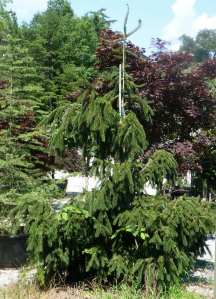Picea abies ‘Cobra’
June 26, 2009
‘Cobra’ Norway spruce was developed at Iseli Nursery. It was a seedling cross between Picea abies ‘pendula’ ( Weeping Norway Spruce) and Picea abies ‘Virgata’ (Norway Snake Spruce). Cobra has characteristics intermediate between both parents. It can become quite large so it should be sited where it can eventually reach its full stature which might be 25 or more ft in our climate . Demonstrating both weeping habit as well as extreme shoot elongation, Cobra is one of the more bizarre appearing conifers, but it is easy to become a fan of this new cultivar. Odd appearing in youth, Cobra grows into its own after a few years. The lowest branches often will form a skirt right on the ground. Staking helps getting the tree growing upright, and being attentive in allowing only one lead shoot

Picea abies Cobra in 75 gal box
(uppermost terminal shoot ) will result in an attractive tree. For the collector, having the two parents on site, and having Cobra, makes for an interesting discussion while enjoying the conifer collection with some visitors.
Salix purpurea ‘pendula’ — Purpleosier willow
June 16, 2009

Salix purpurea 'pendula'
This small weeping tree with thin blue gray leaves and graceful weeping habit, it under-utilized in the modern landscape. It can be used effectively on a slope as most graceful weeping trees look good on slopes, or beside a medium or larger water feature. This tree grows to about 1o ft by 10 ft and prefers full sun and moist to average soil moisture content. Usually grafted on a tall standard,this willow benefits from a hard prune each spring to keep it looking it’s best.
Camperdown Elm — small tree with character
June 15, 2009

Camperdown elm
The Camperdown elm or Ulmus glabra ‘camperdownii’ is a little used landscape choice that attracts attention wherever it is planted. Because it is seldom planted, when it is spotted in the landscape it usually generates question of ‘what is that tree ?” In one way, it’s scarcity in the general landscape has made this tree all the more desirable and interesting. This small weeping tree with bold and heavy branch structure, and medium size deep green leaves can be grown in full sun or shade. It is usually grafted or sometimes budded and trained up to a certain height and allowed to tumble from there. Japanese bettles seem to relish the leaves and fall color is not impressive but otherwise this tree can be strongly recommended. Winter interest is high due to the branch structure ; the weeping branches are not willow-like but more like a wizzened old Japanese maple with many interesting twists and turns. In early spring the greenish wings of the developing seeds look like flowers on the otherwise naked branches. Early leaves are limey green, maturing to deep green. We have this interesting tree for sale at the nursery in several sizes.